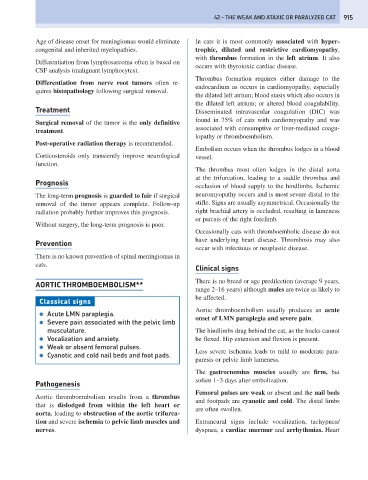Page 923 - Problem-Based Feline Medicine
P. 923
42 – THE WEAK AND ATAXIC OR PARALYZED CAT 915
Age of disease onset for meningiomas would eliminate In cats it is most commonly associated with hyper-
congenital and inherited myelopathies. trophic, dilated and restrictive cardiomyopathy,
with thrombus formation in the left atrium. It also
Differentiation from lymphosarcoma often is based on
occurs with thyrotoxic cardiac disease.
CSF analysis (malignant lymphocytes).
Thrombus formation requires either damage to the
Differentiation from nerve root tumors often re-
endocardium as occurs in cardiomyopathy, especially
quires histopathology following surgical removal.
the dilated left atrium; blood stasis which also occurs in
the dilated left atrium; or altered blood coagulability.
Treatment Disseminated intravascular coagulation (DIC) was
found in 75% of cats with cardiomyopathy and was
Surgical removal of the tumor is the only definitive
associated with consumptive or liver-mediated coagu-
treatment.
lopathy or thromboembolism.
Post-operative radiation therapy is recommended.
Embolism occurs when the thrombus lodges in a blood
Corticosteroids only transiently improve neurological vessel.
function.
The thrombus most often lodges in the distal aorta
at the trifurcation, leading to a saddle thrombus and
Prognosis
occlusion of blood supply to the hindlimbs. Ischemic
The long-term prognosis is guarded to fair if surgical neuromyopathy occurs and is most severe distal to the
removal of the tumor appears complete. Follow-up stifle. Signs are usually asymmetrical. Occasionally the
radiation probably further improves this prognosis. right brachial artery is occluded, resulting in lameness
or paresis of the right forelimb.
Without surgery, the long-term prognosis is poor.
Occasionally cats with thromboembolic disease do not
have underlying heart disease. Thrombosis may also
Prevention
occur with infectious or neoplastic disease.
There is no known prevention of spinal meningiomas in
cats.
Clinical signs
There is no breed or age predilection (average 9 years,
AORTIC THROMBOEMBOLISM**
range 2–16 years) although males are twice as likely to
be affected.
Classical signs
Aortic thromboembolism usually produces an acute
● Acute LMN paraplegia.
onset of LMN paraplegia and severe pain.
● Severe pain associated with the pelvic limb
musculature. The hindlimbs drag behind the cat, as the hocks cannot
● Vocalization and anxiety. be flexed. Hip extension and flexion is present.
● Weak or absent femoral pulses.
Less severe ischemia leads to mild to moderate para-
● Cyanotic and cold nail beds and foot pads.
paresis or pelvic limb lameness.
The gastrocnemius muscles usually are firm, but
soften 1–3 days after embolization.
Pathogenesis
Femoral pulses are weak or absent and the nail beds
Aortic thromboembolism results from a thrombus
and footpads are cyanotic and cold. The distal limbs
that is dislodged from within the left heart or
are often swollen.
aorta, leading to obstruction of the aortic trifurca-
tion and severe ischemia to pelvic limb muscles and Extraneural signs include vocalization, tachypnea/
nerves. dyspnea, a cardiac murmur and arrhythmias. Heart

